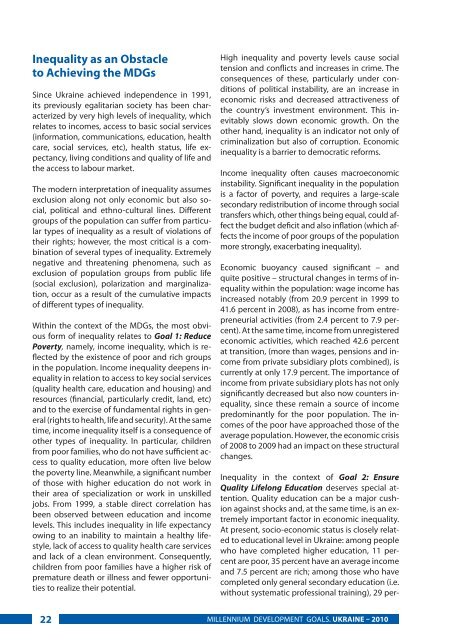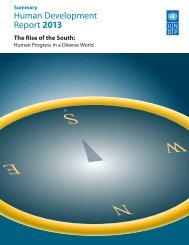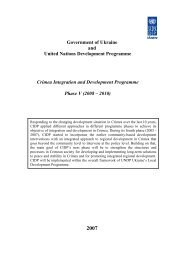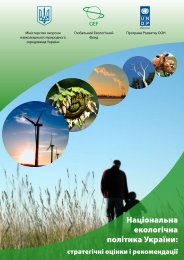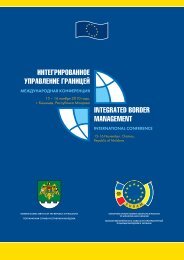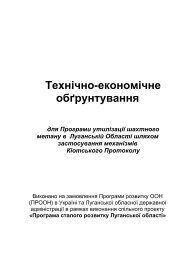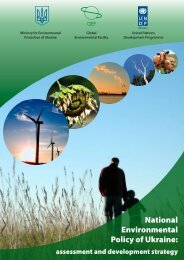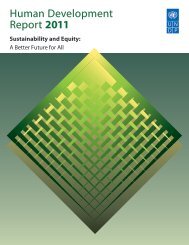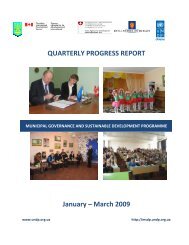MILLENNIUM DEVELOPMENT GOALS ... - UNDP in Ukraine
MILLENNIUM DEVELOPMENT GOALS ... - UNDP in Ukraine
MILLENNIUM DEVELOPMENT GOALS ... - UNDP in Ukraine
- No tags were found...
You also want an ePaper? Increase the reach of your titles
YUMPU automatically turns print PDFs into web optimized ePapers that Google loves.
Inequality as an Obstacleto Achiev<strong>in</strong>g the MDGsS<strong>in</strong>ce Ukra<strong>in</strong>e achieved <strong>in</strong>dependence <strong>in</strong> 1991,its previously egalitarian society has been characterizedby very high levels of <strong>in</strong>equality, whichrelates to <strong>in</strong>comes, access to basic social services(<strong>in</strong>formation, communications, education, healthcare, social services, etc), health status, life expectancy,liv<strong>in</strong>g conditions and quality of life andthe access to labour market.The modern <strong>in</strong>terpretation of <strong>in</strong>equality assumesexclusion along not only economic but also social,political and ethno-cultural l<strong>in</strong>es. Differentgroups of the population can suffer from particulartypes of <strong>in</strong>equality as a result of violations oftheir rights; however, the most critical is a comb<strong>in</strong>ationof several types of <strong>in</strong>equality. Extremelynegative and threaten<strong>in</strong>g phenomena, such asexclusion of population groups from public life(social exclusion), polarization and marg<strong>in</strong>alization,occur as a result of the cumulative impactsof different types of <strong>in</strong>equality.With<strong>in</strong> the context of the MDGs, the most obviousform of <strong>in</strong>equality relates to Goal 1: ReducePoverty, namely, <strong>in</strong>come <strong>in</strong>equality, which is reflectedby the existence of poor and rich groups<strong>in</strong> the population. Income <strong>in</strong>equality deepens <strong>in</strong>equality<strong>in</strong> relation to access to key social services(quality health care, education and hous<strong>in</strong>g) andresources (f<strong>in</strong>ancial, particularly credit, land, etc)and to the exercise of fundamental rights <strong>in</strong> general(rights to health, life and security). At the sametime, <strong>in</strong>come <strong>in</strong>equality itself is a consequence ofother types of <strong>in</strong>equality. In particular, childrenfrom poor families, who do not have sufficient accessto quality education, more often live belowthe poverty l<strong>in</strong>e. Meanwhile, a significant numberof those with higher education do not work <strong>in</strong>their area of specialization or work <strong>in</strong> unskilledjobs. From 1999, a stable direct correlation hasbeen observed between education and <strong>in</strong>comelevels. This <strong>in</strong>cludes <strong>in</strong>equality <strong>in</strong> life expectancyow<strong>in</strong>g to an <strong>in</strong>ability to ma<strong>in</strong>ta<strong>in</strong> a healthy lifestyle,lack of access to quality health care servicesand lack of a clean environment. Consequently,children from poor families have a higher risk ofpremature death or illness and fewer opportunitiesto realize their potential.High <strong>in</strong>equality and poverty levels cause socialtension and conflicts and <strong>in</strong>creases <strong>in</strong> crime. Theconsequences of these, particularly under conditionsof political <strong>in</strong>stability, are an <strong>in</strong>crease <strong>in</strong>economic risks and decreased attractiveness ofthe country’s <strong>in</strong>vestment environment. This <strong>in</strong>evitablyslows down economic growth. On theother hand, <strong>in</strong>equality is an <strong>in</strong>dicator not only ofcrim<strong>in</strong>alization but also of corruption. Economic<strong>in</strong>equality is a barrier to democratic reforms.Income <strong>in</strong>equality often causes macroeconomic<strong>in</strong>stability. Significant <strong>in</strong>equality <strong>in</strong> the populationis a factor of poverty, and requires a large-scalesecondary redistribution of <strong>in</strong>come through socialtransfers which, other th<strong>in</strong>gs be<strong>in</strong>g equal, could affectthe budget deficit and also <strong>in</strong>flation (which affectsthe <strong>in</strong>come of poor groups of the populationmore strongly, exacerbat<strong>in</strong>g <strong>in</strong>equality).Economic buoyancy caused significant – andquite positive – structural changes <strong>in</strong> terms of <strong>in</strong>equalitywith<strong>in</strong> the population: wage <strong>in</strong>come has<strong>in</strong>creased notably (from 20.9 percent <strong>in</strong> 1999 to41.6 percent <strong>in</strong> 2008), as has <strong>in</strong>come from entrepreneurialactivities (from 2.4 percent to 7.9 percent).At the same time, <strong>in</strong>come from unregisteredeconomic activities, which reached 42.6 percentat transition, (more than wages, pensions and <strong>in</strong>comefrom private subsidiary plots comb<strong>in</strong>ed), iscurrently at only 17.9 percent. The importance of<strong>in</strong>come from private subsidiary plots has not onlysignificantly decreased but also now counters <strong>in</strong>equality,s<strong>in</strong>ce these rema<strong>in</strong> a source of <strong>in</strong>comepredom<strong>in</strong>antly for the poor population. The <strong>in</strong>comesof the poor have approached those of theaverage population. However, the economic crisisof 2008 to 2009 had an impact on these structuralchanges.Inequality <strong>in</strong> the context of Goal 2: EnsureQuality Lifelong Education deserves special attention.Quality education can be a major cushionaga<strong>in</strong>st shocks and, at the same time, is an extremelyimportant factor <strong>in</strong> economic <strong>in</strong>equality.At present, socio-economic status is closely relatedto educational level <strong>in</strong> Ukra<strong>in</strong>e: among peoplewho have completed higher education, 11 percentare poor, 35 percent have an average <strong>in</strong>comeand 7.5 percent are rich; among those who havecompleted only general secondary education (i.e.without systematic professional tra<strong>in</strong><strong>in</strong>g), 29 per-22<strong>MILLENNIUM</strong> <strong>DEVELOPMENT</strong> <strong>GOALS</strong>. UKRAINE – 2010


